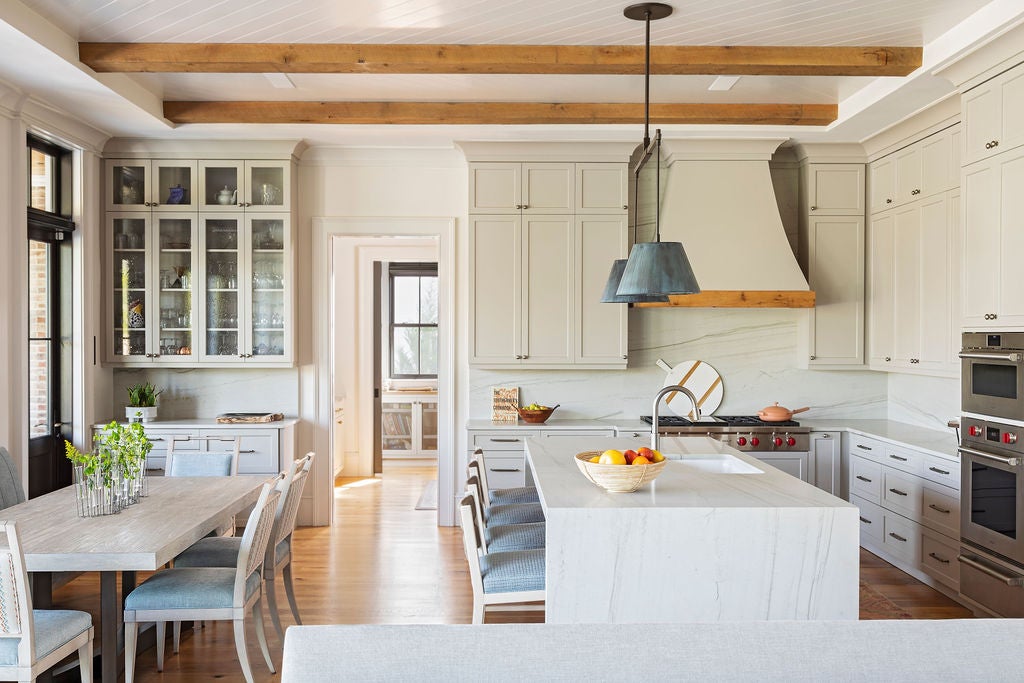Out with the old and in with the new is all well and good, so long as the “old” isn’t creating unnecessary waste. We spoke to seven designers—Hattie Collins, Margaret Donaldson, Lisa Frantz, Don Ricardo Massenburg, Tami Ramsay, Samantha Stathis-Lynch and Rosemary Wormley—about how they offload furniture that clients no longer want.

Shop the house
“I don’t believe in walking into a space and dictating that everything must go. Instead, I love to shop the client’s home for treasured pieces that they have lovingly collected over the years. I respect that they may see value in the furniture items that they have selected. My mission is to discover creative solutions for integrating their existing pieces into the new design or to help those items find a purposeful place in other areas within the home. My mindset has shifted away from viewing home decor and furniture as disposable. I now focus on selecting durable, long-lasting and sustainable items that come with their own unique stories. When there are pieces that don’t fit into the new design, I always encourage our clients to reach out to their network to see if there is a need. A piece that doesn’t quite align with the redesigned space could be a treasured addition to a recent college graduate’s first apartment. This way, we not only promote the sustainable reuse of furniture but also create opportunities for these items to continue their journey, gaining new stories and adding value to the homes of loved ones.” —Don Ricardo Massenburg, Design Inkredible, Durham, North Carolina

Give a little love
“We sometimes consider refinishing or reupholstering clients’ older pieces if they work within the new design scheme, or if they’re a perfect fit for a particular space. Many times a client will have a piece with fantastic lines that just needs a little TLC. We always try to work with heirloom pieces and things that hold sentimental value. For furniture and fixtures that clients are ready to part ways with, we often work with local resellers and consignment shops to make the client a little bit of money on pieces that can find a second life in another home. If we can’t sell a piece, or the client prefers not to, we will coordinate a donation to the Salvation Army’s thrift store or a local charity shop.” —Hattie Collins, Hattie Sparks Interiors, New Orleans

Get creative
“As a small firm that takes on big projects, we have to be resourceful and keep the process from becoming too onerous by outsourcing to trusted partners—from antiques dealers and estate sale companies to luxury market real estate agents looking for high-end staging pieces. We love working old pieces into the plan when it works in the new design. It’s fun to reimagine a beloved piece and use it in a new way. We recently had clients who wanted to go in a different design direction with their new home, and we placed some beautiful modern pieces in a local art gallery that was expanding their space. Facilitating the offload process gives our clients one less thing to worry about and helps to keep their focus on the decision-making for their new project.” —Rosemary Wormley, Ash Street Interiors, Northfield, Illinois

Pass it on
“Many of our clients buy their houses furnished, and though they may keep a piece or two, there is often a lot to get rid of. We will work with any pieces they want to keep and incorporate them in with the furniture we’re proposing. We make suggestions about how to dispose of [anything they don’t plan to keep]. There are consignment shops that will take pieces and the client will get some (although, admittedly, not much) financial return. There are places like Habitat for Humanity that will pick up furniture donations. Donating unwanted items gives the clients a sense of helping out the community, knowing the pieces will be acquired for a nominal price and will be useful to someone else. I also have a large staff, and if the client doesn’t care about the tax write-off that comes with a donation, I will ask if my staff could take it off their hands!” —Margaret Donaldson, Margaret Donaldson Interiors, Charleston, South Carolina

Fresh perspective
“Our first tactic is always to make use of whatever pieces our clients have and still love. As long as an item is of good quality and will work within the new creative vision for their space, we really enjoy breathing fresh life into it. It’s quite mind-blowing what a quality reupholstery job and some fresh stain can do! Inevitably, though, there are pieces that won’t work—whether they are the wrong scale or style, or simply are not worth investing in.”—Tami Ramsay, Cloth & Kind, Athens, Georgia

Get the ROI
“We always offer to help our clients dispose of furniture they no longer want or items that no longer work. For older furniture that is too worn or damaged for resale, we will assist in arranging a Junkluggers or similar type of service pickup—the furniture magically disappears, and they are able to receive a tax deduction. For furniture, lighting, accessories or art that we deem in good condition and ready for resale, we contact our favorite consignment company, Resiklo. We send the photos directly to them, and if the clients are repeat clients, there is a good chance that we have the original paperwork for the item. If we can send supporting documentation to Resiklo, the client can usually get a better return on the consignment fee. We facilitate the delivery or pickup, and Resiklo pays the client directly when the item sells. If it does not sell, the client is given the opportunity to pick up or allow Resiklo to donate to charity. We charge an hourly fee for assisting the client with this service.”—Lisa Frantz, Lisa Frantz Interiors, New York

Trust the process
“If a client has a piece that they want incorporated into their new home, I always try to accommodate their wishes; however, there are a few things I consider when doing so. It’s important that the client understands that we, as designers, do our best work when we are given stylistic freedom and are able to incorporate new and fresh ideas and pieces. If a client wishes to use primarily their former furniture and does not want to acquire new items, they may not be the right fit. Alternatively, if there are pieces that have major sentimental value, I will try to highlight them in my designs. Grandma’s old dresser can look beautiful next to a clean-lined bed frame! It’s important to respect what someone has acquired over the years while simultaneously adding an updated and unique perspective to the space. There should be an understanding between the client and designer that they were hired for a reason and that the artistic process should be respected.” —Samantha Stathis-Lynch, Samantha Ware Designs, Hoboken, New Jersey





























